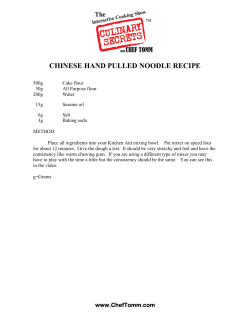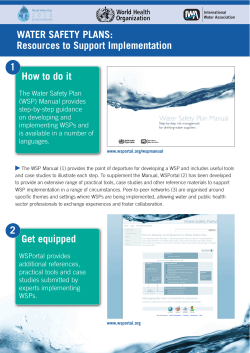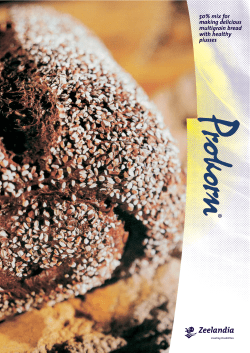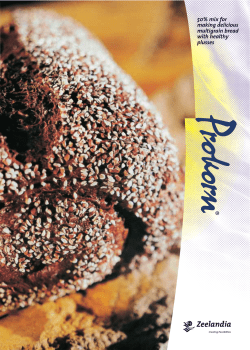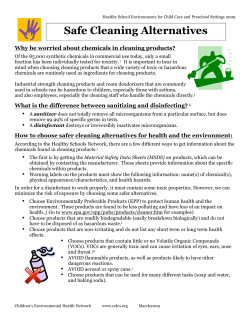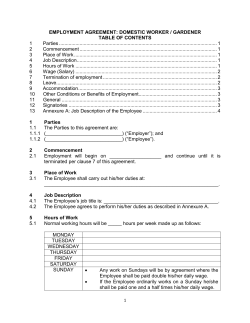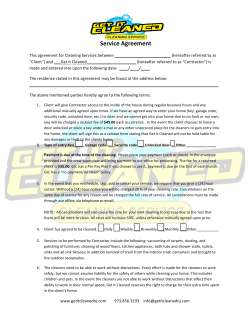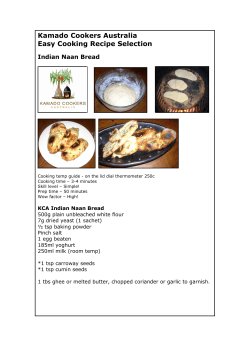
Using KitcHEn EqUiPMEnt safEly Hazard: Exposed Moving Parts on Dough Mixers
Using Kitchen Equipment Safely Moving parts, exposed blades, and nip points are the major hazards of working with kitchen equipment (such as mixers, mincers, processors, and slicers). Cuts, bruises, fractures, and amputations to hands can occur from mincing or cutter plates, and rotating blades. Hazard: Exposed Moving Parts on Dough Mixers & Related Equipment Preparation Read manufacturer’s directions and safety precautions in operations manual Use a cart or trolley to lift or move heavy items Follow the manufacturer’s instructions to install attachments Make sure all guards are in place before using the equipment Did You Know? Equipment should be installed or placed on a level, hard surface that is attached to a sturdy platform All employees must be trained in the correct use of equipment that has moving parts All machines permanently wired to a power source must have a lockout-type disconnect switch All food processing machines should be electrically grounded And Remember… Do not reach into any part of a machine when it is operating in order to add, guide, or adjust food Do not clean any blades or attachments while the machine is running Do not operate any equipment without proper instruction and training HealthandSafetyOntario.ca Details Dough mixers and related equipment, such as kneaders and rounders, may have exposed blades, whisks, paddles, hooks or blending accessories Make sure the bowl is locked in place and all attachments are securely fastened Sometimes they do not have an interlocked guard to prevent them from working when open If lockout is not used during cleaning and maintenance, the machine may start up unexpectedly Threat Serious injury to your hands and arms Death Using Kitchen Equipment Safely Safe Work Guidelines Before You Start Make sure that you have been trained to use and clean the mixer and the guard At All Times Make sure that the mixer is level and attached to a steady surface Follow the manufacturer’s instructions on cleaning, maintenance, and safety Make sure that the OFF switch is easy to reach Make sure that the mixer has a guard (Industrial Establishments Regulation, s.24) Test that the guard works properly (make sure that the mixer cannot work while the guard is raised) Take off any jewellery and loose clothing If you have a large floor model mixer, ensure that you can easily remove the bowl from the mixing portions of the machine Note: Depending on the model, lockout may involve unplugging the mixer or tripping a switch. An electrician may be needed to determine whether an independent circuit breaker, a ground fault circuit interrupter or another device is needed. Do not rely on the interlock guard or switch as a substitute for lockout. Hazard: Exposed Blades or Accessories on a Slicer While You Are Working Turn the machine off to load ingredients or to adjust food Stay with the machine until all mixing is done and you have cleaned the mixer While You Are Cleaning the Mixer or Changing Accessories Unplug the machine – if you cannot control the plug while you are cleaning the mixer or if the machine is wired into the wall; –– Lockout the control switches –– After completing lockout, check that no one can move any part or start the machine and that no parts can move on their own 2 © 2011, Safe Workplace Promotion Services Ontario, publicly known as Workplace Safety & Prevention Services. 1 877 494 WSPS (9777) | 905 614 1400 | www.wsps.ca Details Pushing food into a slicer without a guard may result in injuries Threat Cuts Broken bones Amputations Safe Work Guidelines At All Times Make sure the slicer is level and attached to a steady surface Follow the manufacturer’s instructions on cleaning, maintenance and safety Make sure that the slicer has a guard (Industrial Establishments Regulation, s.24) Using Kitchen Equipment Safely Before You Start Make sure that you have been trained to use and clean the slicer and the guard Take off any jewellery and loose clothing Test that the slicer works properly before use (make sure that the guard allows the food to be cut without exposing the slicer blade) Prepare your ingredients Hazard: Nip Point on a Bread Slicer While You Are Working Use the guard Do not use your hand to push food Always keep your thumb positioned behind the thumb guard Attach a last-slice device or pusher to keep from being injured at the end of a section Turn the thickness setting to zero after each use Never reach across the blade for any reason Concentrate on what you are doing – do not talk with anyone While Cleaning the Slicer Unplug the machine – if you cannot control the plug while you are cleaning the slicer or if the machine is wired into the wall: –– Lockout the control switches –– After completing lockout, check that no one can move any part or start the machine and that no parts can move on their own Put on cut-resistant gloves Ask a qualified person to sharpen the slicer blade If a machine will not be used for extended periods, use an electrical plug lockout cap 3 © 2011, Safe Workplace Promotion Services Ontario, publicly known as Workplace Safety & Prevention Services. 1 877 494 WSPS (9777) | 905 614 1400 | www.wsps.ca Details A worker’s fingers may be caught in a nip point created by multiple blades when the slicer is operating Threat Finger cuts Amputations Safe Work Guidelines At All Times Report any defect in the operation of the switch right away and make sure that the unit is properly serviced Do not allow your fingers or hands to touch the knives When you are removing the sliced bread from the machine: –– Place one hand against each end of the sliced loaf –– Lift the loaf out of the rack –– Place the loaf on the bagging attachment When you cut bread with a hard crust (e.g., rye), very hot bread or soft-textured bread, consider modifying your cutting motion: –– Take extra care (e.g., soft bread may need a slightly slower downward motion of the knife frame until the knives have entered the hard crust) Using Kitchen Equipment Safely While You Are Using the Bread Slicer All bread slicers operate differently; know how your specific slicer operates Use the handle on the front of the machine to raise the knife frame up until it stays there and the bread rack moves forward Place the bread to be sliced in the receiving trough and raise the operating handle on the right side of the machine (this automatically operates the motor switch and starts the knife frame on its downward slicing motion) Note: For more advanced cleaning and maintenance (e.g., removing and replacing knife frames or knives in frames, lubrication, etc.), call a professional service person. Crushing Hazard on a Dough Moulder Details A worker’s fingers and/or hand can be pulled in and crushed within the rollers and belts Threat Note: The switch will shut off automatically when the knife frame reaches its bottom position. Crushed fingers While You Are Cleaning the Bread Slicer Safe Work Guidelines If you are not sure about cleaning procedures, ask your supervisor If necessary, check the manufacturer’s manual Disconnect the machine from the power source – if you cannot control the plug while you are cleaning the bread slicer or if the machine is wired into the wall: –– Lockout the control switches –– After completing lockout, check that no one can move any part or start the machine and that no parts can move on their own Remove all machine parts that come into contact with the bread (e.g., knife-frame assemblies, bagging trough, holding rack) Wash all these parts thoroughly with mild detergent and warm water, and then rinse and dry them When you reassemble the parts, check the operator’s manual Wipe down the outside of the machine with a mild detergent and warm-water solution: –– Do not spray or allow water to enter any interior mechanical parts –– Rinse off the outside of the machine using a cloth that you have dampened in warm water At All Times 4 © 2011, Safe Workplace Promotion Services Ontario, publicly known as Workplace Safety & Prevention Services. 1 877 494 WSPS (9777) | 905 614 1400 | www.wsps.ca Amputations Any hoppers that are attached to the machine should be designed so that workers’ hands are kept away from the rollers and belts Make sure all guards are in place and not being bypassed during use (IER, s.24); machines should not be able to run when the guards are not properly in place Follow the instructions provided in the owner’s manual, on how to safely operate the equipment Turn the machine off when not in use Before You Start Ensure that you have been properly trained to use the moulder; if not, discuss this with your supervisor Make sure all guards are in place and that the emergency button, or the OFF switch, are easily accessible While You Are Cleaning the Dough Moulder Make sure the machine is off and has been properly locked out Guards should be easily removable (when in lockout mode), in order to ease cleaning of the machinery Using Kitchen Equipment Safely For Further Reference: For more information on the safe use and guarding of kitchen equipment, refer to the following resources: CSA Z432, Safeguarding of Machinery Health and Safety Executive (UK), A Baker’s Dozen: Thirteen Essentials for Health and Safety in Bakeries ANSI Z50.1, For Bakery Equipment – Safety Requirements © Workplace Safety & Prevention Services 2011. Workplace Safety & Prevention Services (WSPS) grants permission to approved end users to reproduce this document in whole or in part, provided its intended use is for non-commercial, educational purposes and that full acknowledgement is given to the WSPS. Approved end users are firms registered with the Workplace Safety and Insurance Board. WSPS reserves the right to extend this permission to other stakeholders and interested parties by express written permission upon application. WSPS extends no warranty to materials amended or altered by the end user. Under no circumstances is this document, or any portion thereof, to be duplicated for purposes of sale or for external reproduction or distribution. Revised: June 2011 5 © 2011, Safe Workplace Promotion Services Ontario, publicly known as Workplace Safety & Prevention Services. 1 877 494 WSPS (9777) | 905 614 1400 | www.wsps.ca
© Copyright 2025
